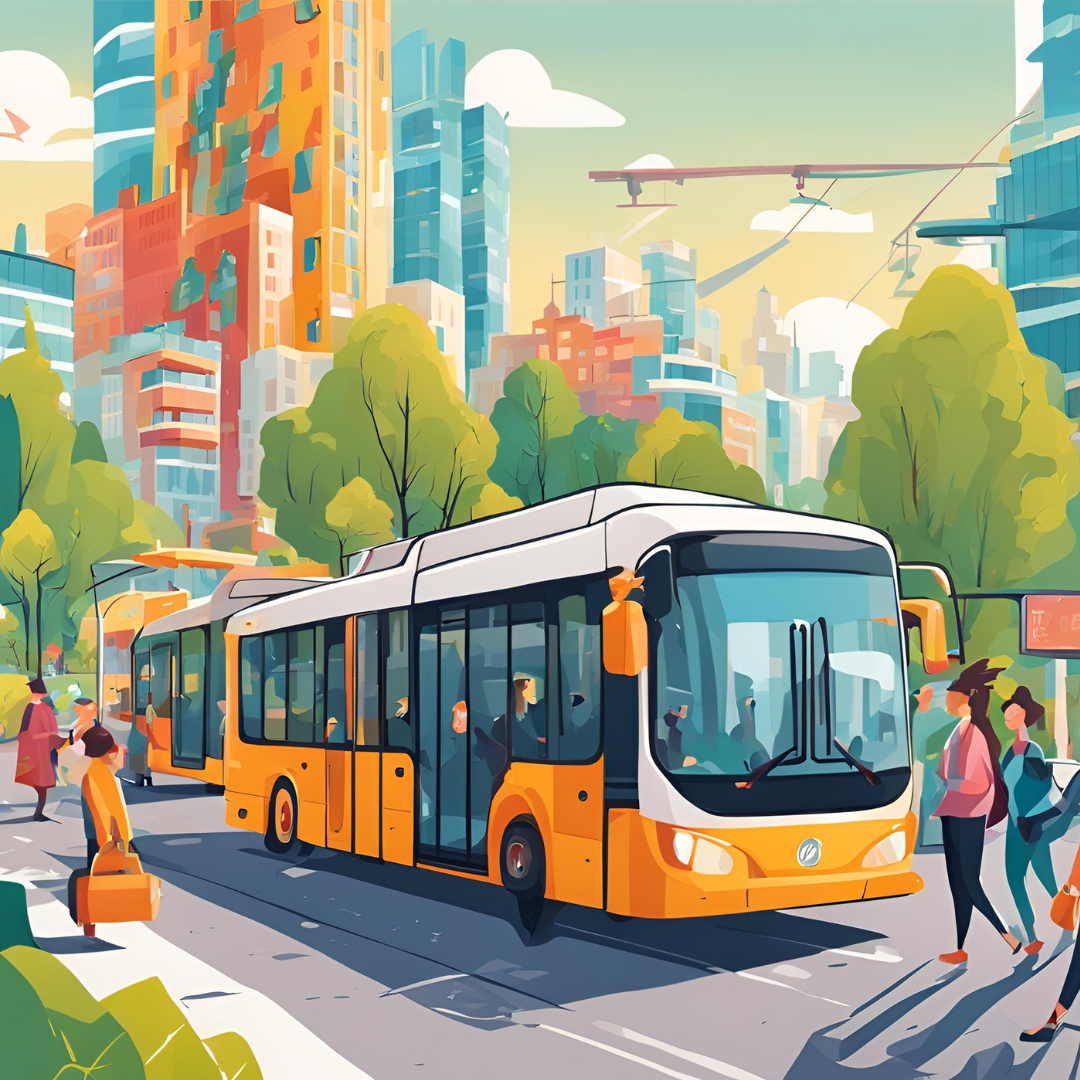Navigating Transit: Performance Metrics & Funding
In the evolving landscape of public transportation, funding is essential to enhancing services and expanding the reach of transit agencies like Charlottesville Area Transit (CAT). With this in mind, C3 has embarked on a blog series examining the relationship between performance metrics, competitive and non-competitive State and Federal funding programs, and the decisions—from the small to the great—that transit agencies can implement to maximize their share of annual grant funding.
Our first blog in the series looked at CAT’s relative prowess in attracting ridership compared to three other Virginian transit agencies. CAT’s consistent annual downward ridership between 2015 and 2023 proved to be an outlier compared to Blacksburg Transit (BT), the Greater Richmond Transit Company (GRTC), and Arlington Transit (ART) [1]. This week, we explore metrics beyond ridership that can be leveraged to enhance competitiveness, focusing on the most significant funding sources available to CAT.
Major Funding Streams: The Lifeblood of Transit Agencies
Public transit agencies track several key metrics to demonstrate their effectiveness in meeting the diverse needs of commuters and communities.
Ridership Numbers: The total number of passengers carried.
Operating Costs: The expenses incurred in providing transit services.
Vehicle Revenue Hours (VRH): The number of hours that vehicles are in service.
Vehicle Revenue Miles (VRM): The number of miles that vehicles travel while in service.
These metrics are reported quarterly to Virginia’s Department of Rail and Public Transportation (DRPT) and annually to the Federal Transit Administration (FTA). Funding authorities like DRPT and FTA use these metrics to evaluate an agency’s operational efficiency, service quality, and financial sustainability [2][3].
Figure 1: Slide 44 of Kimley-Horn’s presentation at the City Council Work Session on Alternative Fuels [4]
In conversation with C3 about the standout funding streams for transit in both the Charlottesville and Richmond areas, which represent C3’s current service areas [5], DRPT Statewide Transit Planning Manager Dan Sonenklar noted a number of significant available Federal and state funding programs, including both formula (i.e. non-competitive) and discretionary (i.e. competitive) funding [6]. In particular, these include:
Federal:
FTA 5307 formula funds, used for urbanized areas (UZAs) between 50,000 and 200,000. Grants from this fund are awarded on a standard formula relating to population, low-income population, and population density [7].
FTA 5339 formula and discretionary funds:
5339(a) formula grants and 5339(b) discretionary grants offer funding for the purchase of buses and bus-related facilities, with funds from 5339(a) apportioned to small agencies like CAT as part of their applications for State-awarded MERIT - Capital Assistance funding [8].
5339(c) Low or No Emission Vehicle Program specifically supports the acquisition of low-or-no-emission vehicles and related infrastructure, with applications open every year from February to mid-to-late April.
Other discretionary programs for specific projects:
RAISE (Rebuilding American Infrastructure Sustainability and Equity) funding, formerly known as BUILD or TIGER, is authorized by the Bipartisan Infrastructure Law to “pursue multi-modal and multi-jurisdictional projects that are more difficult to fund through other grant programs” [9].
FTA 5309 - CIG provides critical grants for larger transit capital infrastructure investments, including new and expanded rail and bus rapid transit projects [10].
State:
MERIT (Making Efficient and Responsible Investments in Transit): A state-level funding program in Virginia, MERIT provides grants to transit agencies for both capital projects and operating assistance.
MERIT Operating Assistance, apportioned competitively on the basis of relative performance between transit agencies in the State.
MERIT Capital, awarded for capital projects and investments based on criteria that follow Virginia’s SMART SCALE legislation [11].
MERIT Special Programs for technical assistance, demonstration assistance, and workforce development [12].
Transit Ridership Incentive Program (TRIP): Along with numerous other Virginian transit agencies, both CAT and GRTC have used TRIP funding, which was “designed to improve regional transit service in large urban areas and reduce barriers to transit access for low income individuals” [13], to pilot fareless transit programs in their localities.
Understanding Scoring Formulas: The Key to Competitive Funding
Taking a deeper dive into the specifics of an important funding stream for CAT, there are two major considerations for MERIT Operating Assistance allocation: Size-Weight and Performance. Both of these factors consider aspects of the agency’s operations, like ridership and expenses, but utilize different approaches: at its most basic level, Size-Weight is calculated using the raw values of service (e.g. an agency’s ridership), while Performance is determined by the agency’s growth or improvement in efficiency over the past few years (e.g. improvements to cost efficiency).
Size-Weight and Performance metrics are multiplied by each other to determine the share of available state funding that the agency will receive, meaning that they are both critical for the creation of performance goals. A large Size-Weight with poor Performance (e.g. a large system with no improvement in cost-efficiency), or a small Size-Weight with great Performance (e.g. a small system with growing ridership trends), likely will not score as well as an agency that scores high on both factors.
Each transit agency scrutinized using these calculations is then compared against each other, with MERIT - Operating Assistance funds allocated proportionately according to the agencies’ relative performance. So, for example, if all agencies being examined experienced a drop in ridership during the studied time period, then the agency with the lowest percentage drop would score the highest in this performance metric, despite having still lost riders.
Beyond Ridership: Leveraging Alternative Metrics
While ridership is a highly significant factor in determining funding eligibility, it is by no means the only metric that matters. As well as MERIT - Operating Assistance, competitive grants such as FTA 5339(b) and (c) go beyond this single indicator of success.
Take, for example, FTA 5339(c) Low or No Emission Program. The scoring criteria for these programs incorporates the age and condition of the current fleet, the need for fleet expansion or replacement, and the environmental benefits of proposed projects. Crucially, however, a zero-emission transition plan must be in place before funding will be awarded. Because of this, it remains just out of reach for agencies like CAT, committed to pursuing decarbonization of their transit fleet, but without a finalized decarbonization plan [14]. Expanded access to funding is just another reason for agencies to focus major attention on decarbonization!
Source: FTA 5339(c) Low or No Emission Program
Service Usability: Metrics related to service efficiency, such as on-time performance, cost per passenger mile, and the ability to reduce congestion, can also strengthen an application. Even if ridership numbers are not higher than other transit agencies competing for the same funding, consistent improvement in these areas over time is one way that an agency like CAT - whose ridership is increasing at a slower rate than peer agencies in Virginia [15] - can still remain competitive.
Community Impact: Projects that address unmet needs within the community, such as expanding service to underserved areas or improving accessibility for people with disabilities, can be particularly compelling in writing a strong grant application, for example under TRIP funding [16]. Such initiative demonstrates a broader commitment to equity and inclusion, which resonate strongly with transit funding agencies that increasingly value equitable transit.
Zoning density: While formula funding based on metrics such as population and density is not typically described as “competitive,” it is interesting to consider the relationship between zoning and transit agencies’ access to this type of funding. When smart growth and transit-oriented development, which require collaboration between planning commissions and transit planners, are prioritized in these urbanized areas, this has the power to allow transit agencies to access more funding - in effect, making them more competitive. Setting up a regional transit authority likewise has this power by expanding the footprint of the agency and thereby, its population.
Approach with Nuance
To make CAT more competitive in securing funding, it is crucial to adopt a strategic approach that goes beyond ridership. By understanding and leveraging alternative metrics such as environmental impact and population densities, CAT and its service partners in the Charlottesville area can craft compelling grant applications that resonate with funding agencies.
Likewise, our transit leaders must stay adaptable to the evolving criteria and priorities of funding programs. As state and federal governments increasingly prioritize sustainability and equity, CAT's focus on these areas can advance its burgeoning position as a leader in innovative and community-oriented transit solutions that can exceed even its own already ambitious decarbonization goals.
Next week, we discuss Charlottesville City Council and Albemarle County’s upcoming vote to set up a Regional Transit Authority (RTA), how the performance metrics discussed in the first two blogs would be impacted by an RTA, and what that means for residents of both jurisdictions. (Spoiler alert: it’s a good thing!)
Special thanks to our Spring intern Katie Larson for all of her excellent, in-depth analysis of the MERIT - Operating Assistance program!
Sources
[1] Sadhbh O’Flynn (2024), “Riding the Metrics: Public Transit Performance in Virginia”. Available at: https://theclimatecollaborative.org/blog/2024/8/21/riding-the-metrics-public-transit-performance-in-virginia
[2] Virginia Department of Rail and Public Transit (2023), "Transit and Commuter Assistance Grant Application Manual". Available at: https://drpt.virginia.gov/wp-content/uploads/2023/10/FY25-Transit-and-Commuter-Assistance-Grant-Application-Manual-Blue-Book.pdf
[3] Virginia Secretary of Transportation (2019), "RD529 - How the Commonwealth Is Using Transit and Transportation Demand Management to Reduce Congestion and Use of Single-Occupant Vehicles". Available at: https://rga.lis.virginia.gov/Published/2019/RD529
[4] Charlottesville Area Transit (2024), “City Council Work Session: Review of Recommendations – February 2024.” Available at: https://charlottesvilleva.portal.civicclerk.com/event/2073/files/attachment/4778, slide 44.
[5] Maria Duster (2024), "Growing Together: C3 Expands to Richmond!" Available at: https://theclimatecollaborative.org/blog/2024/6/27/growing-together-c3-expands-to-richmond
[6] Dan Sonenklar (DRPT Statewide Transit Planning Manager) in conversation with C3, May 30, 2024.
[7] Federal Transit Administration (2022), "Section 5307 Urban Area Formula Grants". Available at: https://www.transit.dot.gov/sites/fta.dot.gov/files/2022-06/Section-5307-Urbanized-Area-Program-BIL-update.pdf
[8] Dan Sonenklar (DRPT Statewide Transit Planning Manager) in conversation with C3, May 21, 2024.
[9] US Department of Transport (2024), "Rebuilding American Infrastructure with Sustainability and Equity (RAISE)". Available at: https://www.transportation.gov/RAISEgrants
[10] US Department of Transit, "Capital Investment Grants - 5309". Available at: https://www.transit.dot.gov/capital-investment-grants-5309
[11] Department of Rail and Public Transportation (2024), “MERIT - Capital Assistance Program Prioritization Scoring”. Available at: https://drpt.virginia.gov/wp-content/uploads/2023/11/FY25-Capital-Assistance-Program-Prioritization-Technical-Guidance_FINAL-110923.pdf
[12] Department of Rail and Public Transportation, "Our Grant Programs". Available at: https://drpt.virginia.gov/our-grant-programs/merit/
[13] Virginia Association of Counties (2021), "Virginia Department of Rail and Public Transit Announces Transit Ridership Incentive Program Materials Open for Public Comment". Available at: https://www.vaco.org/county-connections/virginia-department-of-rail-and-public-transit-announces-transit-ridership-incentive-program-materials-open-for-public-comment/
[14] Federal Transit Administration, "Zero Emission Fleet Transition Plan". Available at: https://www.transit.dot.gov/funding/grants/zero-emission-fleet-transition-plan
[15] Sadhbh O’Flynn (2024), “Riding the Metrics: Public Transit Performance in Virginia”. Op cit.
[16] Department of Rail and Public Transportation (2024), “Transit and Commuter Assistance Grant Application Manual”. Available at: https://drpt.virginia.gov/wp-content/uploads/2023/11/FY25-Transit-and-Commuter-Assistance-Grant-Application-Manual-Blue-Book.pdf




